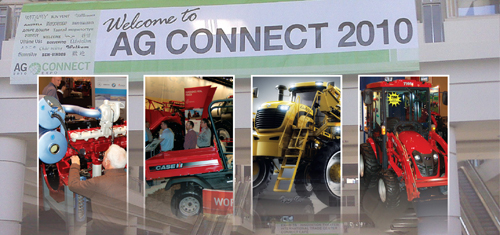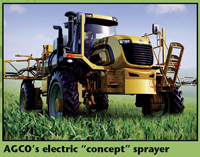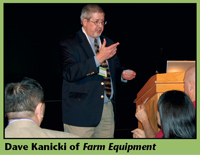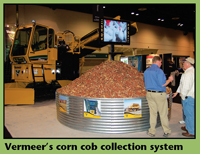
Ag Connect’s debut in January demonstrated potential to be a different kind of show. Here are some of Farm Equipment’s observations on this first-time-ever exhibition.
A Farm Equipment Staff Report
Of the more than 7,000 visitors attending the first three days of Ag Connect Expo, an estimated 800 were farm equipment dealers, according to the Assn. of Equipment Manufacturers (AEM), organizers of the ag machinery show that debuted January 12-15 in Orlando, Fla.
Not bad for a first-time effort, but nowhere near the numbers anticipated or that the industry was led to believe early on. But we came away feeling that it will get better as this new exposition of farm equipment establishes itself as “not just another show.”
Numbers are usually the measure of success for exhibitions like Ag Connect. Big numbers are usually equated with success. But this inaugural event will be remembered more for the type of visitors it attracted than its number of visitors.
Of the 7,000-plus attendees, about 25% were exhibitors. According to AEM, nearly 80% of the producer registrants were farm owners or operators who work an average of 2,900 acres per farm. Of these, the same number, 80%, participate in on-the-farm purchasing decisions.
Compared with other major farm equipment shows, Ag Connect has a lot of growing to do if it’s going to make it to the big leagues of ag machinery exhibitions. Nonetheless, it did accomplish its goal of attracting an international audience.
An International Flavor
Billed as a “world-class international forum for agriculture industry professionals,” Ag Connect appears to have succeeded at that level. One farmer from west Tennessee who attended the event told Farm Equipment, “I’m really impressed with the number of international visitors at this show.”
Asked if he’d come back, he said, “Yeah. I’m pretty sure I will.”
If things work out the way the show’s organizers would like, in a couple of years Ag Connect will be on an every-other-year cycle, rotating with Agritechnica, the huge farm machinery show held every 2 years in Hanover, Germany.
With its formal opening ceremony and more exhibitors and attendees wearing jackets and ties, this show more closely reflected the atmosphere of a European exposition than any of the other big North American farm shows.
For the record, AEM reports that about 20% of all registrants were from outside the U.S., with 62 countries represented among the participants. In addition, delegations from 20 countries participated, including 16 through the U.S. Commerce Dept.’s International Buyer Program.
The show also included pavilions from Argentina, Brazil, Canada, China and Europe.
Good Looking Show
There’s little question that the Orange County Convention Center in Orlando is an outstanding facility. In appearance, setting and convenience alone, it puts most other big exposition venues like Chicago’s McCormick Place to shame. Of course, they’re maintaining one tradition that most U.S. exhibit halls have in common — $9 sandwiches of marginal quality, which is not the European way of feeding visitors.
That aside, this was a good-looking show with a fair amount of farm machinery to see. Whether the exhibitors were displaying their newest equipment was another matter. More often than not, exhibitors suggested that Farm Equipment editors visit them at the National Farm Machinery Show (NFMS) in Louisville, Ky., where they’ll be rolling out their latest and greatest products and equipment.
So, this will be a double-edged challenge for Ag Connect with it being held within weeks of two other major, established expositions: NFMS in Louisville, and the World Ag Expo in Tulare, Calif. Both of these shows are traditionally held the same week in February, a month or less after Ag Connect. It’s estimated that each of these annual expositions attracts 100,000 or more attendees each year.
One of the advantages that Ag Connect has, and one that it should exploit, is the information it gathers on its registered attendance. While the other major ag equipment exhibitions claim big numbers, they don’t provide a breakout of those numbers by producers, dealers, exhibitors and/or other types of visitors. This leaves room to question the type and quality of attendees at those shows. It’s clearly a selling point for AEM to exhibitors.
It may also be a signal to the other major farm equipment show organizers to make more of an effort to provide their exhibitors with solid demographic data to justify their investments. As an exec of one of the major equipment makers told Farm Equipment, “This show gives us leverage when negotiating with these other shows.”
The Innovation Cycle
In addition to putting pressure on the resources of exhibitors that traditionally show at Louisville and/or Tulare, both of which bill themselves as international events, the dates for Ag Connect relative to these shows also forces attendees to make a decision of which to attend.
Even beyond these considerations, a grass-roots question posed by several exhibitors that Farm Equipment spoke with involved the number and frequency of national ag machinery shows. In light of their innovation cycle, the frequency issue is particularly challenging for shortline equipment manufacturers.
A CEO for one of the “larger” shortliners suggested that its goal is turn out at least one major new product every 2 years, but it often takes 3 years to assure it’s ready to go to market. But, of course, he felt the company “needed to be here” at Ag Connect to reinforce that it is a major player in the industry.
Costs for exhibiting were also mentioned by several exhibitors as a problem. Some indicated that the cost of booth space at Ag Connect was “too high.” As a result, they chose to buy enough space to have a “presence” but not enough to accommodate their equipment. This, of course, lessens the overall impact of an exposition of machinery and led to a decision to roll out their newest equipment at the NFMS in Louisville.
A manufacturer of compact and utility tractors happily reported that it had retailed 2 units on the first day of the show, but added, “We’ll need to sell a few more to cover the costs of being here.”
One exhibitor suggested that Ag Connect consider allying with an existing national exposition. He said, “Ag Connect has potential, but it needs to consider partnering with another major show” if it hopes to be successful in the long run.
They’ll Be Back
The two equipment manufacturers most conspicuous in their absence were New Holland and Kubota. But based on the success of the first Ag Connect, it’s a good bet that they’ll be there for the next one.
For the most part, the equipment makers who exhibited at Ag Connect 2010 say they’re planning to return for the 2011 show. That one will be held January 7-10 in Atlanta. Following that, it will return to Orlando in 2013.
Many of the exhibitors that Farm Equipment visited with didn’t hide the fact that they were expecting higher visitor traffic that they’ve become accustomed to at national equipment shows.
At the same time, they allowed for the fact that it was the “first time” for Ag Connect.
Despite the light traffic, most of the manufacturers offered that they weren’t at all disappointed by the “quality” of show visitors. “They were here looking to buy,” one exhibitor told Farm Equipment. “That’s why we exhibit at these shows, to talk to customers who have plans to buy.”
By most accounts, these were people who knew the right questions to ask and, more importantly, were decisions makers. Ag Connect didn’t attract the “tire kickers” that can be prevalent at other equipment shows.
With 312 total companies taking 167,800 net square feet of exhibit space in the 2010 event, it appears that Ag Connect showed enough for two-thirds of those same exhibitors to sign on for the 2011 show. How that one is attended could tell a lot about this show’s long-term staying power.
AGCO Shows Off New Concept Vehicle

Hybrids aren’t just cars anymore. AGCO’s new ElectRogator offers further evidence that electric vehicles can effectively reduce fuel use and improve the overall performance of ag equipment. According to Paul Haefner, product marketing specialist for AGCO, the ElectRogator sprayer is operated by a 311-horsepower, C9 diesel engine that uses electrical motors instead of hydraulic drives. “It produces 659 volts of power and turns at 1,900 rpm with 6 speed ranges,” says Haefner. “It also provides 35% more torque — or power to the ground — than equipment with hydraulic drives.” He explains that unlike hydraulic drives, electric motors produce the same torque at 1 mph as they do at 35 mph. While stressing that the ElectRogator is only a concept vehicle, Haefner adds that the main driver behind its development is fuel savings and, so far, it’s demonstrating a 20% reduction in overall fuel use.
Farm Equipment Presents 2010 Sales Outlook at Ag Connect

Dave Kanicki, executive editor of Farm Equipment and Ag Equipment Intelligence, made the first presentation in the Innovations Theater to a standing-room-only crowd at Ag Connect. Kanicki presented the results of the 2010 Business Outlook & Trends survey of more than 300 ag machinery dealers in North America. “It will be difficult in 2010 to live up to the outstanding sales performances of 2008 and 2009,” he said. “At the same time, dealers still see solid sales in the year ahead.” Among the dealer’s top pick for best selling products in ’10 are GPS/auto-steer systems, rectangular balers, self-propelled sprayers and tillage equipment, including disc harrows and chisel plows.
Precision Systems Expand Ag Applications

Both Raven Industries and Hemisphere GPS made major announcements at Ag Connect that will further extend the equipment they offer for precision farming. Raven introduced it Slingshot system of improving and simplifying connectivity through mobile telephone networks. According to the company, this means that regions throughout North America that previously couldn’t use precision ag technology will now have access through Raven’s RTK correction signals, online services and data management. The service and equipment required is being sold through farm equipment dealers, says Ryan Molitor. Hemisphere GPS also introduced its new Outback eDriveX centimeter-level auto-steering system. According to Jeff Farrar of Hemisphere, the new precision offered by the eDriveX and A220 smart antenna will open up a wider range of applications for Hemisphere customers including nutrient placement, seeding and other tasks requiring precise placement of inputs.
Growing Potential Seen for Biomass Equipment

Equipment for harvesting and gathering biomass for use as cellulosic biofuels continues to grow as several firms exhibited several new products at Ag Connect. Vermeer’s exhibit showed a complete system for collecting and baling corn cobs. According to Vermeer’s Jay Van Roekel, one of the major challenges will be how much residue can be collected and how much needs to remain to protect and nourish the soil. He expects that growing and harvesting biomass will be an expanding market for ag machinery during the next decade.





